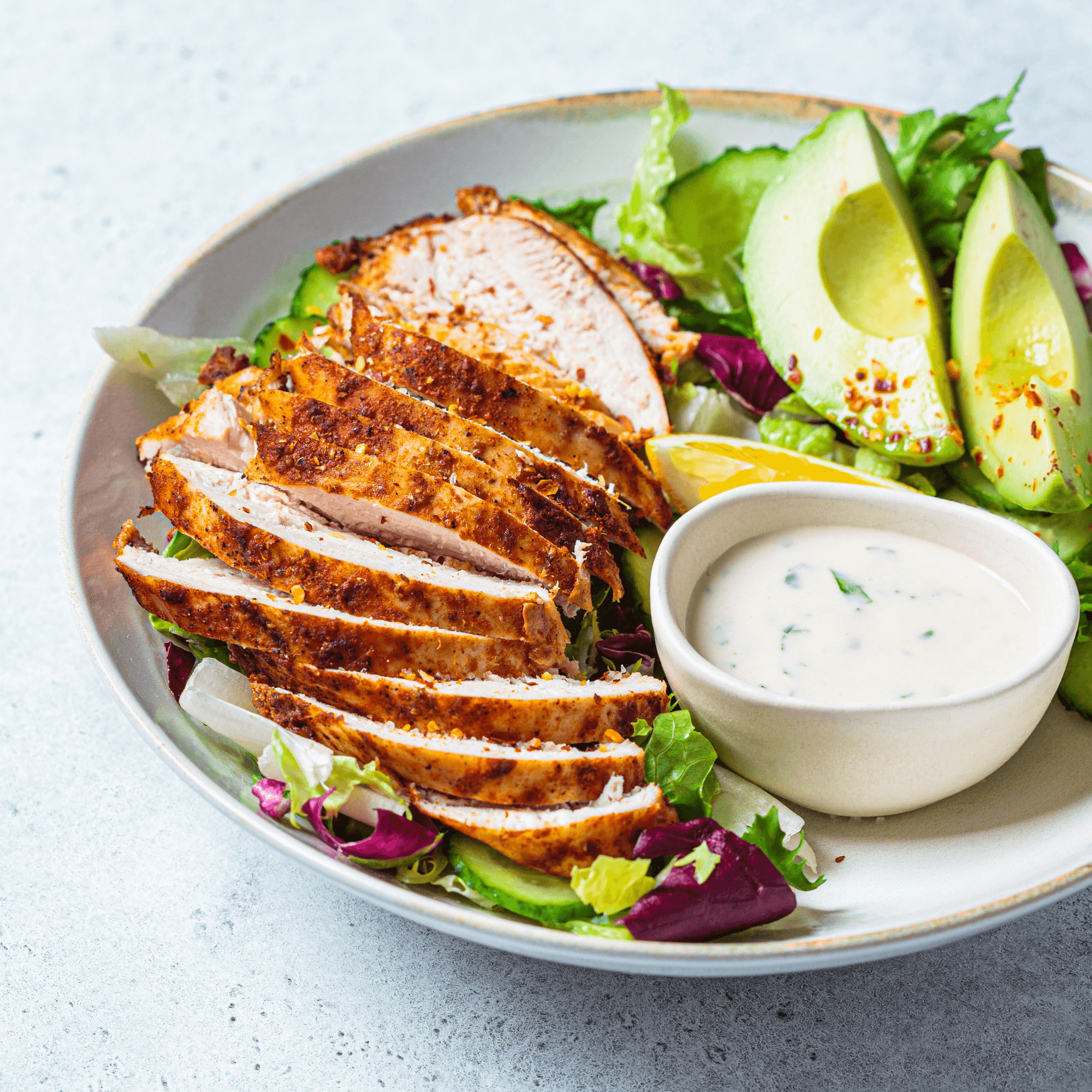
Welcome to your health journey! Embarking on a keto diet can seem overwhelming, but fear not, with the right guidance, it can be an incredibly rewarding experience. This comprehensive guide is designed to provide you with all the information you need to kickstart your health journey as a keto beginner. From understanding the basics to essential tips and tricks, this guide will set you on the path to success.
Key Takeaways
- Starting a keto diet is a big step towards improving your overall health
- With the proper essentials, understanding of macros, and food choices, staying on track can be easy
- Meal planning, dining out, and tracking progress are all important parts of the journey
- Challenges may arise, but with consistency and determination, you can overcome them and achieve long-term success
- Enjoy the benefits of improved well-being and vitality!
What is the Keto Diet?
Welcome to the world of the keto diet – a low-carb, high-fat approach to eating that has been gaining popularity in recent years. The keto diet involves drastically reducing your carbohydrate intake and replacing it with healthy fats, which puts your body into a state of ketosis.
Ketosis is a metabolic process that occurs when your body doesn’t have enough glucose (from carbohydrates) for energy and instead burns fat for fuel. This process can lead to weight loss, increased energy, and other potential health benefits.
The keto diet has been used for decades as a treatment for epilepsy but has now gained popularity as a weight loss and overall health program.
The Science Behind the Keto Diet
When you eat carbohydrates, your body breaks them down into glucose, which is used for energy. However, when you drastically reduce your carbohydrate intake, your body needs to find an alternative energy source. That’s where fat comes in. When your body burns fat for energy, it produces molecules called ketones, which are used as fuel instead of glucose.
By following a high-fat, low-carb diet, you can enter a state of ketosis, which can have a range of benefits for your health, including weight loss, improved insulin sensitivity, and reduced inflammation.
The Basics of the Keto Diet
So, what does a typical keto diet look like? Here are the basics:
- Limit your carbohydrate intake to 20-50 grams per day
- Consume moderate amounts of protein
- Get the majority of your calories from healthy fats, such as avocado, olive oil, and nuts
Overall, the keto diet can be a great option for those looking to improve their health and lose weight. However, it’s important to talk with your healthcare provider before starting any new diet program to ensure it’s right for you.
Getting Started: Keto Essentials
Before embarking on your keto journey, it’s essential to have the right tools and mindset. Here, we’ll provide you with a list of keto essentials to ensure that you have everything you need to succeed.
Pantry Staples
The following items are essential pantry staples for a keto diet:
| Item | Description |
|---|---|
| Coconut oil | A healthy source of saturated fat that is ideal for high-heat cooking |
| Olive oil | A heart-healthy oil that is ideal for dressings and low-heat cooking |
| Nuts and seeds | A great source of healthy fats and protein; choose almonds, walnuts, chia seeds, and flaxseeds |
| Low-carb vegetables | Stock up on keto-friendly veggies like spinach, kale, broccoli, and cauliflower |
| Spices | Add flavor without adding carbs with spices like cumin, turmeric, and paprika |
Kitchen Tools
The following kitchen tools will help make your keto journey easier:
- Food scale: For measuring portions and tracking macros
- Slow cooker: Make easy and delicious keto meals with minimal effort
- Spiralizer: Turn veggies like zucchini and sweet potato into delicious low-carb noodles
- Blender: Perfect for making keto smoothies, soups, and sauces
Meal Planning Tips
Keto meal planning can seem daunting, but with a few simple tips, you can make it a breeze:
- Plan your meals in advance: Set aside time each week to plan your meals for the upcoming week.
- Shop regularly: Plan your grocery trips around your meal plan to ensure that you have all of the ingredients you need.
- Batch cook: Make large batches of meals and freeze them for easy meals throughout the week.
- Track your macros: Use a food journal or app to track your macros and ensure that you’re staying within your daily limits.
With these keto essentials in your arsenal, you’ll be well on your way to achieving your health and wellness goals.
Understanding Macros on Keto
If you’re new to the keto diet, you may have heard the term “macros” floating around. Macros, or macronutrients, are the three main components of the food we eat: carbohydrates, protein, and fat.
On keto, tracking your macros is essential for ensuring that you’re staying within the diet’s guidelines. The ideal keto macro breakdown is 75% fat, 20% protein, and 5% carbs. This breakdown allows your body to enter a state of ketosis, where it burns fat for fuel instead of carbs.
Calculating Your Macros
Calculating your macros may seem daunting at first, but it’s pretty straightforward once you get the hang of it. First, you’ll need to determine your daily calorie needs, which will depend on factors like your age, gender, weight, and activity level.
Next, you’ll need to calculate your daily macronutrient needs based on your calorie needs and the ideal macro breakdown. There are many online calculators and apps that can help you with this, or you can consult with a nutritionist or dietitian.
Once you have your macro goals, you’ll need to track your food intake to ensure that you’re staying within your limits. Many people use apps like MyFitnessPal or Carb Manager to track their macros and stay on track with their goals.
The Importance of Macros on Keto
Tracking your macros is important on keto for several reasons. First, it ensures that you’re getting enough fat to fuel your body and stay in ketosis. Second, it helps you avoid overeating protein, which can be converted into glucose and kick you out of ketosis. Finally, tracking your carbs ensures that you’re staying within the diet’s guidelines and not consuming too many carbs to maintain ketosis.
Adjusting Your Macros
As you progress on the keto diet, you may need to adjust your macros to suit your goals. For example, if you’re not seeing the weight loss or other results you want, you may need to lower your calorie intake or adjust your macro breakdown to better align with your needs.
Consulting with a nutritionist or dietitian can be helpful in making these adjustments, especially if you have specific health concerns or goals.
Tracking your macros may take some effort, but it’s an important part of the keto diet. By staying within your macros, you’ll ensure that you’re getting the right balance of nutrients to fuel your body and achieve your health goals.
Keto-Friendly Food Choices
One of the keys to success on the keto diet is making smart food choices that align with its principles. Here are some essential keto-friendly foods you should include in your diet:
| Protein Sources | Healthy Fats | Low-Carb Vegetables | Alternatives to High-Carb Foods |
|---|---|---|---|
| Meat (Beef, Chicken, Pork, Lamb) | Butter | Leafy Greens (Spinach, Kale, Arugula) | Almond Flour |
| Fish (Salmon, Trout, Tuna) | Coconut Oil | Cauliflower | Coconut Flour |
| Eggs | Olive Oil | Broccoli | Unsweetened Cocoa Powder |
| Nuts and Seeds (Almonds, Chia Seeds, Flaxseeds) | Avocado Oil | Asparagus | Stevia |
It is essential to avoid high-carb foods, such as grains, sugars, and processed foods. Instead, opt for natural, whole foods that are low in carbs and high in healthy fats.
Keep in mind that while these foods are keto-friendly, portion control and moderation are still important. Overeating even keto-friendly foods can stall weight loss and hinder progress.
Experimenting with different food combinations and recipes is essential for keeping your diet fresh and tasty. Don’t be afraid to get creative in the kitchen and try new things!
Meal Planning and Recipes
Meal planning is a crucial part of the keto diet. It helps ensure that you have the right balance of macronutrients and prevents you from giving in to unhealthy temptations. Here are some tips to help you plan your meals:
- Focus on protein: Make sure each meal has plenty of protein. Good options include meat, fish, eggs, and tofu.
- Incorporate healthy fats: Don’t be afraid of fat, but make sure you’re choosing healthy sources like avocado, olive oil, and nuts.
- Choose low-carb vegetables: Vegetables are an important part of any diet, but on keto, it’s important to choose those that are low in carbs. Leafy greens, broccoli, cauliflower, and zucchini are all great choices.
- Plan ahead: Take some time each week to plan out your meals and snacks. This will help you stay on track and avoid impulsive decisions.
Now, let’s take a look at some delicious keto-friendly recipes:
| Meal | Recipe |
|---|---|
| Breakfast | Avocado and Bacon Breakfast Sandwich Ingredients: 1 avocado, 4 slices of bacon, 2 eggs, 1 tbsp mayonnaise, 1 tbsp olive oil Instructions: 1. Cook bacon in a skillet until crispy. 2. Slice avocado in half, remove the pit, and scoop out the flesh. 3. In a separate skillet, cook eggs in olive oil to your liking. 4. Build sandwich by spreading mayonnaise on one half of the avocado and placing bacon and eggs on top. Top with the other half of the avocado. |
| Lunch | Buffalo Chicken Salad Ingredients: 2 cups shredded chicken, 1/4 cup buffalo sauce, 1/4 cup ranch dressing, 1/2 head iceberg lettuce, 1/2 cup cherry tomatoes, 1/4 cup shredded cheddar cheese Instructions: 1. Mix together shredded chicken and buffalo sauce. 2. In a separate bowl, mix ranch dressing with a little bit of water to thin it out. 3. Chop lettuce and halve cherry tomatoes. 4. Assemble salad by layering lettuce, cherry tomatoes, chicken, and cheese. Drizzle with ranch dressing. |
| Dinner | Stuffed Bell Peppers Ingredients: 4 bell peppers, 1 lb ground beef, 1/2 onion, 2 cloves garlic, 1/2 cup tomato sauce, 1/2 cup shredded cheddar cheese, 1 tbsp olive oil Instructions: 1. Preheat oven to 375°F. 2. Cut tops off bell peppers and remove seeds and membranes. 3. Dice onion and garlic. 4. Heat olive oil in a skillet over medium heat. Add onion and garlic and cook until softened. 5. Add ground beef to the skillet and cook until browned. Drain excess fat. 6. Stir in tomato sauce and spoon mixture into each bell pepper. 7. Place stuffed peppers in a baking dish and bake for 25-30 minutes. Sprinkle cheese on top during the last 5 minutes of baking. |
Remember, these are just a few examples of the many delicious meals you can enjoy on the keto diet. Get creative and have fun experimenting with new recipes!
Navigating Keto-Friendly Dining Out
Eating out while on the keto diet can be a challenge, but it doesn’t have to derail your progress. By following these tips, you can make keto-friendly choices while still enjoying dining out:
- Choose protein-rich dishes like steak, chicken, or fish and ask for them to be grilled or baked instead of fried.
- Swap high-carb sides like french fries or baked potatoes for steamed or roasted vegetables.
- Avoid sauces or dressings that are high in carbs and opt for olive oil or vinegar instead.
- Order salads with keto-friendly ingredients like leafy greens, nuts, seeds, and avocado, and ask for dressing on the side.
- Look for restaurants that offer cauliflower rice or zucchini noodles as a low-carb alternative to traditional rice or pasta dishes.
It’s also important to plan ahead and research the menu or restaurant before you go. Most places have their menus available online, so you can see which options are keto-friendly and plan accordingly. If you’re unsure about a dish or its ingredients, don’t be afraid to ask your server for more information.
“Can you recommend any keto-friendly options on the menu?”
Remember, it’s okay to make modifications or ask for substitutions to make a dish more suitable for your dietary needs. Stick to your keto principles and enjoy your meal out with confidence!
Overcoming Keto Challenges
The keto diet can come with a few challenges that may affect your progress. In this section, we will address some common keto challenges and provide helpful strategies for overcoming them.
Keto Flu
One common side effect of starting the keto diet is the keto flu. This is a collection of symptoms that may occur as your body adjusts to the new way of eating. Symptoms may include headaches, fatigue, irritability, and nausea.
To overcome the keto flu, make sure you are drinking enough water and electrolytes. You can get electrolytes through supplements or by consuming potassium and magnesium-rich foods such as leafy greens, avocado, and nuts.
Cravings
Cravings can be tough to overcome, especially when you are just starting on the keto diet. It’s important to remember that cravings are often the result of habit or emotional triggers, rather than actual hunger.
One strategy for overcoming cravings is to distract yourself with a non-food related activity, such as taking a walk or calling a friend. You can also try substituting high-carb foods with keto-friendly alternatives. For example, if you’re craving sweets, try a keto-friendly dessert like berries with whipped cream or sugar-free chocolate.
Plateaus
If you’re not seeing progress on the scale, you may be experiencing a plateau. This can be frustrating, but it’s important to remember that weight loss is not always linear.
To overcome a plateau, try mixing up your exercise routine or adjusting your macros. You can also try intermittent fasting or incorporating more high-intensity interval training (HIIT) into your workouts.
Staying Motivated
Staying motivated can be challenging, especially if you’re not seeing immediate results. One strategy is to set realistic, achievable goals and track your progress along the way. Celebrate your successes, no matter how small, and don’t beat yourself up for slip-ups or setbacks.
You can also try finding a support system, whether it’s through a friend, online group, or professional coach. Having someone to hold you accountable and offer encouragement can make a huge difference.
Remember, the keto diet is a journey, and it’s normal to face challenges along the way. With perseverance and a positive attitude, you can overcome any obstacle and achieve your health goals.
Tracking Progress and Adjusting
As you continue on your keto journey, it’s important to track your progress to ensure you’re achieving your goals. While the scale is an easy way to measure success, it’s not the only metric you should be monitoring. Tracking your body measurements, energy levels, and overall well-being can provide valuable insights into your health progress.
Consider keeping a journal to track your meals, exercise routines, and any challenges or successes you encounter. This can help you identify patterns and make necessary adjustments to your approach.
Tracking Metrics Beyond the Scale
While weight loss is often a primary goal for those on the keto diet, it’s not the only measure of success. Here are some additional metrics to track:
| Metric | Why it’s important | How to track |
|---|---|---|
| Body measurements | Can show changes in body composition, even when the scale doesn’t move | Use a tape measure to track changes in waist, hips, thighs, and other areas |
| Ketone levels | Can indicate whether you’re in ketosis, which is necessary for the diet’s effectiveness | Use a ketone meter or test strips to measure ketone levels in your blood, breath, or urine |
| Energy levels | Can demonstrate whether the diet is helping or hindering your energy levels and fatigue | Take note of your energy levels throughout the day, before and after meals, and during exercise |
| Mental clarity | Can indicate how the diet is affecting your brain function and focus | Take note of your mental clarity, focus, and productivity throughout the day |
Adjusting Your Approach
If you’ve hit a plateau or are experiencing other challenges on the keto diet, it may be time to adjust your approach. Here are some strategies to try:
- Adjust your macronutrient ratios: Tweaking the amounts of fat, protein, and carbs you consume can help break a weight loss plateau or improve energy levels.
- Experiment with intermittent fasting: This can help jumpstart weight loss and improve insulin sensitivity.
- Incorporate more physical activity: Adding regular exercise can boost weight loss and improve overall health.
- Try new recipes: Eating the same foods day in and day out can get boring, so mix it up with new and exciting keto-friendly recipes.
Remember, the keto diet is highly individualized, and what works for one person may not work for another. Don’t be afraid to experiment and try new things until you find what works best for you and your health goals.
Staying Consistent and Maintaining Long-Term Success
Now that you have started your keto journey as a beginner, it’s important to stay consistent and committed to maintaining long-term success. Here are some tips to help you on your way:
Stick to Your Plan
One of the keys to staying consistent is to stick to your keto plan. Meal planning and preparation can help you stay on track and avoid impulsive decisions that may derail your progress. Make sure to have healthy keto-friendly snacks on hand and plan ahead for dining out or social events.
Track Your Progress
Tracking your progress can help you stay motivated and adjust your approach as needed. Beyond just tracking your weight, consider monitoring other metrics like body measurements, energy level, and overall well-being. This will help you get a clear picture of how the diet is working for you and any adjustments that may need to be made.
Stay Accountable
Having someone to share your progress and challenges with can help you stay motivated and accountable. Consider finding a keto buddy or joining a support group to connect with others on the same journey. Celebrate your wins together and offer support and encouragement when challenges arise.
Maintain Healthy Habits
Consistency is about more than just sticking to your diet plan. It’s important to maintain healthy habits like exercise, hydration, and restful sleep to support your overall well-being and maintain long-term success. Remember, the keto diet is just one part of a healthy lifestyle.
By staying consistent and committed to your keto journey, you can achieve long-term success and enjoy the benefits of improved health and vitality.
Conclusion
As we come to the end of this guide, we hope that you have gained a comprehensive understanding of the keto diet and how it can benefit your health journey as a beginner. By embracing the principles of a low-carb, high-fat diet, you can enjoy improved energy levels, better mental clarity, and weight loss.
Stay Committed to Your Health Journey
Remember, success on the keto diet requires commitment and consistency. It’s important to stay motivated and stick to your meal plan, even when faced with challenges or setbacks. Build healthy habits and keep making progress towards your goals.
Monitor and Adjust Your Approach
To ensure long-term success, it’s vital to track your progress and adjust your approach as needed. Keep an eye on your metrics beyond the scale, such as energy levels and mental clarity, to gauge the effectiveness of your diet. If you reach a plateau or experience keto flu symptoms, don’t be discouraged. Instead, adjust your macros, try new recipes, or consult with a healthcare professional for guidance.
Enjoy the Benefits of Improved Health
Finally, remember that the keto diet is not just a short-term solution, but a lifestyle change that can yield long-term benefits for your health and well-being. By staying consistent and committed to this health journey, you can enjoy sustained weight loss, increased energy, and a healthier, happier you.
Thank you for taking the time to read this guide. We wish you the best of luck on your keto journey, and hope that it brings you the health and vitality you deserve.
FAQ
What is the keto diet?
The keto diet is a low-carb, high-fat diet that aims to put your body in a state of ketosis, where it burns fat for fuel instead of carbohydrates. It has been shown to have potential benefits for weight loss, increased energy levels, and improved mental clarity.
How do I get started on the keto diet?
To get started on the keto diet, you’ll want to first familiarize yourself with the principles and guidelines. This includes understanding which foods are keto-friendly and how to calculate and track your macronutrient intake. It can also be helpful to meal plan and stock up on keto essentials, such as healthy fats and low-carb vegetables.
What are macros on the keto diet?
Macros, short for macronutrients, refer to the three main nutrients your body needs in large quantities: carbohydrates, fats, and proteins. On the keto diet, keeping track of your macros is crucial, as you’ll want to consume a high percentage of fats, moderate protein, and very few carbs to promote ketosis.
What are some keto-friendly food choices?
Keto-friendly food choices include sources of healthy fats like avocados, nuts, and olive oil, as well as protein sources such as eggs, poultry, and fish. Low-carb vegetables like broccoli, cauliflower, and spinach are also great options. Additionally, there are alternatives to high-carb foods, such as cauliflower rice or zucchini noodles.
How can I plan meals on the keto diet?
Planning your meals on the keto diet involves selecting recipes that align with the principles of the diet, which are high in healthy fats, moderate in protein, and low in carbs. It can be helpful to plan your meals in advance, batch cook, and have keto-friendly snacks on hand to stay on track.
How can I make keto-friendly choices when dining out?
When dining out on the keto diet, it’s important to choose dishes that are low in carbs and high in healthy fats and proteins. Opt for grilled or roasted meats, salads with full-fat dressings, and non-starchy vegetables. You can also ask for modifications to fit your dietary needs, such as replacing carb-heavy sides with extra veggies.
What are some common challenges on the keto diet?
Some common challenges on the keto diet include experiencing the keto flu during the initial transition, dealing with cravings for carb-rich foods, and hitting plateaus in weight loss. However, there are strategies to overcome these challenges, such as staying hydrated, incorporating keto-approved snacks, and adjusting your macros as needed.
How do I track my progress on the keto diet?
Tracking your progress on the keto diet goes beyond just stepping on a scale. You can monitor your results by measuring body measurements, assessing changes in energy levels and mental clarity, and tracking other health markers like blood sugar or cholesterol levels. Adjusting your approach as needed based on these indicators is crucial for long-term success.
How can I stay consistent on the keto diet?
Staying consistent on the keto diet involves building healthy habits and staying motivated. Set realistic goals, plan your meals ahead of time, find support from like-minded individuals, and focus on the positive changes you’re experiencing. Remember that consistency is key to maintaining long-term success.





